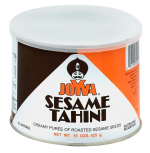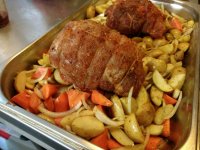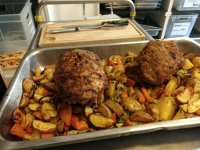In fact this is little help, the world of industrial food is being fully embraced. The real thing is simply going to cost so much eventually that it will no longer be viable.
@Cal I don't know about powdered versions of the real thing but ultra reduction followed by dilution later IME modifies the taste.
A little help please: measuring & using tahini paste
Does anyone have a technique, or a trick, or a piece of household wisdom, about how to measure out a tablespoon of tahini paste? And how to get it to incorporate with other ingredients in, for example, a small amount of salad dressing?
The stuff I buy (pictured below) is a dense solid brick at the bottom of the can, with an inch of viscous oil floating atop. But it's so dense and so insoluble in oil, that I can't dig it out with a spoon. If I do manage to break off a boulder using a knife, it's never a 1 tablespoon boulder. How do YOU measure a tablespoon of tahini paste? And how do you get the boulder to dissociate into individual tahini particles which mix with the other ingredients??
Serious question! Thanks very much.
_
Does anyone have a technique, or a trick, or a piece of household wisdom, about how to measure out a tablespoon of tahini paste? And how to get it to incorporate with other ingredients in, for example, a small amount of salad dressing?
The stuff I buy (pictured below) is a dense solid brick at the bottom of the can, with an inch of viscous oil floating atop. But it's so dense and so insoluble in oil, that I can't dig it out with a spoon. If I do manage to break off a boulder using a knife, it's never a 1 tablespoon boulder. How do YOU measure a tablespoon of tahini paste? And how do you get the boulder to dissociate into individual tahini particles which mix with the other ingredients??
Serious question! Thanks very much.
_
Attachments
Mark,
When I buy butter the wrapper is marked in tablespoons. So if your's are you should be able to get a rectangular dimension.
The other method is Archimedes, use a cup of water and take out a spoonful. Add until the water comes back to the full level.
As to breaking it up, chisel off a piece and pound between fabric.
Of course store it upside down to let the oil move around.
Now how to chop it up....
When I buy butter the wrapper is marked in tablespoons. So if your's are you should be able to get a rectangular dimension.
The other method is Archimedes, use a cup of water and take out a spoonful. Add until the water comes back to the full level.
As to breaking it up, chisel off a piece and pound between fabric.
Of course store it upside down to let the oil move around.
Now how to chop it up....
Last edited:
And how do you get the boulder to dissociate into individual tahini particles which mix with the other ingredients??
Serious question! Thanks very much.
_
Mortar and pestle? You should have to weigh out a tbsp only once and remember it, but unless there is an important chemical reaction happening I never measure very carefully.
Word is China is going to run with this platform (there are big players involved) and in time nothing will go into China without being RFID tagged and everything produced within China will be tagged also.In fact this is little help, the world of industrial food is being fully embraced. The real thing is simply going to cost so much eventually that it will no longer be viable.
Of course there is whole lot of infrastructure involved in recording all production steps and ownership steps from paddock to plate and the 'rules' and legal frameworks are being defined now.
The driving point of this GWorld authentification and secure payments platform is that counterfeiting of goods is eliminated and quality claims are proven and can be trusted....think baby formula scandal etc, the local honey industry is the starting point, other industries will follow.
Yes 'industrial food' is endemic and at present there are no real controls on what is in it and where it came from, Gworld is about traceabley enforcing standards and providing trusted provenance information to the consumer, ie informed choice.
When we buy for example a jar of honey from a major supermarket do any of us have any real idea of what's in it, where it came from, it's purity, it's pesticide content status, it's UMF level etc.....this is set to change and other food industries will follow.
Dan.
Mark,
BTY, storage temperate and time are what causes the paste to become a brick. Heating it with fresh olive oil can turn it back into a creamy paste.
As a youngling I never saw it as the creamy paste most folks expect today. I think the recipe in the family was almost brick like.
The idea of premade would have surprised my grandfathers cook.
However I have also seen it used as hard lumps in some cooking. But that was by my great aunts. The most interesting difference is how they fried things. At least half an inch of oil in the frying pan.
BTY, storage temperate and time are what causes the paste to become a brick. Heating it with fresh olive oil can turn it back into a creamy paste.
As a youngling I never saw it as the creamy paste most folks expect today. I think the recipe in the family was almost brick like.
The idea of premade would have surprised my grandfathers cook.
However I have also seen it used as hard lumps in some cooking. But that was by my great aunts. The most interesting difference is how they fried things. At least half an inch of oil in the frying pan.
Try to open the jar from below, then it will be more convenient to dig out the necessary pieces. This is similar to our halva which is sold by weighing and cut with a knife. http://mir-orekhoff.ru/wp-content/uploads/2018/02/halva_tahinnaya.jpgDoes anyone have a technique, or a trick, or a piece of household wisdom, about how to measure out a tablespoon of tahini paste? And how to get it to incorporate with other ingredients in, for example, a small amount of salad dressing?
The stuff I buy (pictured below) is a dense solid brick at the bottom of the can, with an inch of viscous oil floating atop. But it's so dense and so insoluble in oil, that I can't dig it out with a spoon. If I do manage to break off a boulder using a knife, it's never a 1 tablespoon boulder. How do YOU measure a tablespoon of tahini paste? And how do you get the boulder to dissociate into individual tahini particles which mix with the other ingredients??
Serious question! Thanks very much.
_
Last edited:
Yes 'industrial food' is endemic and at present there are no real controls on what is in it and where it came from, Gworld is about traceabley enforcing standards and providing trusted provenance information to the consumer, ie informed choice.
I have no interest in the provenance of things like autolyzed yeast, I'm not sure you understand what I meant by erosion of standards.
When we buy for example a jar of honey from a major supermarket do any of us have any real idea of what's in it, where it came from, it's purity, it's pesticide content status, it's UMF level etc.....this is set to change and other food industries will follow.
Testing like DNA testing for mislabeled fish costs lots of money, no one is going to pay the difference. The only solution is to go back to local personal sourcing.
Last edited:
The only solution is to go back to local personal sourcing.
Exactly......it’s usually much cheaper also. Just a little more effort involved, but worth it!
Exactly......it’s usually much cheaper also. Just a little more effort involved, but worth it!
Yes honey, for instance, these folks are 30min away.
Dropped by to buy a 5 gallon pail of honey for mead making. The man working the warehouse was SUPER friendly and helpful. He gave us taste samples of about 8 honeys and answered all of our questions. Most of their honey is sold in the natural raw state and is delicious! The cranberry was my favorite.
Yes honey, for instance, these folks are 30min away.
Where I am is The center of Tupelo honey production.....it’s a interesting honey in that it never granulates and is high fructose/lower glucose than most so it’s safer for diabetics.....and it has a delicate perfume like taste that’s quite unique.
If anyone ever orders any make sure it’s 100% pure raw Tupelo......there’s many that blend with other lesser honey and pass it off as ‘tupelo honey’ and I believe industry standard allows quite a bit of dilution while still retaining the moniker ‘Tupelo honey’
Check out the film with Peter Fonda ‘Ulee’s Gold’ it was filmed in and based on my area. I’m 10 miles from wewahitchka.
Re: rock hard tahini in a can
Replies I received on middle eastern food sites weren't very different from the ones here (or found with simple Google searches)
Replies I received on middle eastern food sites weren't very different from the ones here (or found with simple Google searches)
- Dump out the entire contents of the can and use an electric mixer to create a smooth non lumpy paste. Measure what you want and store the rest. Turn the storage container upside down every other day.
- Warm the unopened can in a bowl of hot water for an hour. Then do the above.
- Don't buy national brand tahini, seek out specialty middle eastern markets and buy tahini there
- Open the "wrong" (bottom) end of the can and slide the brick of tahini out backwards. Chop it up with a knife, then follow the electric mixture procedure above.
When we buy for example a jar of honey from a major supermarket do any of us have any real idea of what's in it, where it came from, it's purity, it's pesticide content status, it's UMF level etc.....this is set to change and other food industries will follow.
Dan.
When I go to any major supermarket around here they all sell Cosman & Whidden honey (Cosman and Whidden Honey - Pure Nova Scotia Honey). I know where it is made, I know where their hives are placed, and I know what is in the honey. There are smaller local producers as well which I can visit (like "The Buzz" at Wood n Hive Honey - Pure Nova Scotia Honey - Alex Crouse on Starr's Point (my daughter's middle name is Starr, because my wife's family is descended on one side from Capt John Starr, a New England Planter who settled at Starr's Point)). The last thing I need is RFID to tell me where my honey comes from.
Before, after. A pork roast from the leg, stuffed and rubbed with a mix of paprika powder, rosemary, breadcrumbs, olive oil (and a tad too much salt tbh).
Wow that looks good, especially the roasted veggies!
- Home
- Member Areas
- The Lounge
- The food thread



